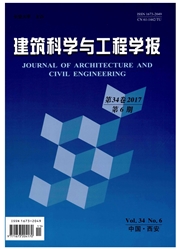

 中文摘要:
中文摘要:
对膜结构风振响应中的流固耦合效应进行了探讨,介绍了解决该问题的两种思路:简化气弹模型方法和计算流体力学(Computational Fluid Dynamics,CFD)数值模拟方法。简化气弹模型方法是先将流固耦合效应用附加质量和气动阻尼的形式采表达,再通过某些近似解析理论和气弹模型风洞试验来确定附加质量和气动阻尼的大小。计算流体力学数值模拟方法则是将计算流体力学技术和计算结构力学技术整合在一个有限元程序中,通过数值模拟得到结构流固耦合响应的全过程信息。基于这两种方法,开展了相应的理论推导、风洞试验和数值模拟工作,获得了关于风与膜结构相互作用机理的一些初步认识。最后提出了一种具有操作性的简化数值分析方法并给出了算例。研究结果表明:流固耦合效应对结构风振响应的影响在多数情况下是有利的,即考虑流固耦合效应的风振响应分析结果要比不考虑流固耦合时小30%左右,但也不排除在某些特殊情况下因出现气弹失稳而导致结构异常破坏的可能性。
 英文摘要:
英文摘要:
Researches on fluid-solid interaction effect of wind-induced vibration response and membrane structure were discussed. The two methodologies for solving this problem were introduced firstly. The first was a simplified aeroelastic model method. In this method, these additional aerodynamic feedback terms were described as added mass and aerodynamic damping, which could be studied by potential flow theory or wind tunnel test. The second was computational fluid dynamics simulation method. In this method, the computational fluid dynamics codes and computational structural dynamics codes were integrated into one program, Using this program, the process of wind-structure interaction can be simulated in time domain. Based on these two methods, corresponding works were done by means of theoretical derivation, wind tunnel test and numerical simulation. According to these works, some preliminary understandings of the mechanism of wind and membrane structures interaction were gotten. Finally, a simplified numerical simulation method was proposed. It is proved that this method is easier to handle than those above mentioned methods. It can be concluded that the couple effects are favourable for wind induced vibration response under most conditions, which mean the results from wind structure interaction analysis are about 30% smaller than those analysis methods without consideration of the exist some special cases that couple effects. Meanwhile, it can not be excluded that there maybe membrane structures can be destroyed by aeroelastic instability.
 同期刊论文项目
同期刊论文项目
 同项目期刊论文
同项目期刊论文
 期刊信息
期刊信息
